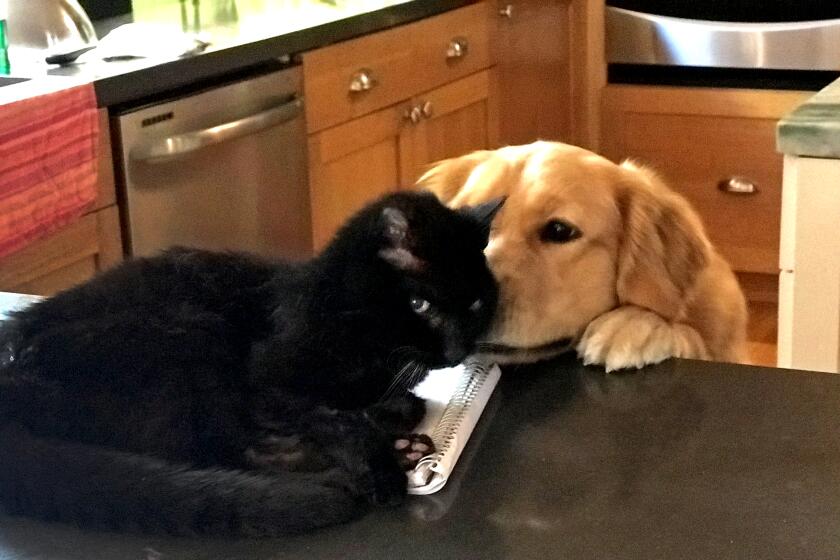Column: I’m the foster mom of four pit bull mix puppies, and loving it

- Share via
Just before Christmas, my animal-loving daughter Chloe moved back to L.A. from grad school in Connecticut. She brought her pet rabbit, Sweet Pea, with her on the plane, and moved in with her fiance, who was already living with their elderly cat, Ferdinand.
I was slightly annoyed when Chloe announced that she and Anton had taken in a hugely pregnant rescue dog, Laney, and they might not be able to participate in family holiday events, as the dog was on the verge of exploding with offspring. Also, the folks at Wags & Walks, the rescue they were working with, told her that Laney, in her pregnant state, might be “reactive” around other dogs.
Really? I thought. You’re back in L.A. after 12 years in Berkeley, San Francisco and New Haven, and you’ll be playing canine midwife instead of joining us for Christmas dinner?
Laney turned out to be non-reactive in almost all ways. A super mellow pit bull mix (we assume) who resembles nothing so much as a bat-eared, brindled dingo, she was fine around our family pets. We quickly grew to love her. And we waited, increasingly alarmed, as she became wider and wider and wider, until finally, three days after New Year’s, she popped.
Laney delivered nine tiny puppies in Chloe and Anton’s living room. With the help of their friend Natasha, they christened them after famous bears: Yogi, Boo-Boo, Baloo, Paddington, Pooh, Smokey, Fozzie, Charmin … and (for Hulu fans) Chef.
For the next month, Chloe and Anton barely slept. They worried about the puppies being smothered, of course, but mainly they were kept awake by the gastrointestinal distress of a dispirited mama dog who needed to get outside every few hours, or else.
Did I mention they live on the third floor? And that a month in, the elevator broke, and Anton was forced to carry 45-pound Laney up and down because she was terrified of stairs?
“We have reached our breaking point,” Anton texted me one morning in early February. “We’re taking Laney and the pups back to Wags & Walks.” Laney was exhausted too. Nourishing nine sharp-clawed puppies was just too much for her.
Before he died, I promised my father that I would care for Inky, his cat, no matter what. It hasn’t been easy. I had no idea she would wreck my home.
After some rest and medical attention, Laney is now up for adoption on the group’s website.
But what would become of nine four-week old puppies until they were old enough to go home with new owners? The litter would have to be divided into manageable groups and put in foster care.
Which is how, dear reader, I came to be the foster mom of four little scamps, who are, as I write this, asleep on their bed in my kitchen after spending two joyful hours running around the house, wrestling one another and daring Poppy, my befuddled 2-year-old golden retriever, to fight them.
These four little guys are the source of endless joy.
Ravenous eaters, they are also the source of endless puddles of pee and poop.
I knew nothing about the animal foster system before Chloe and Anton brought Laney and her pups into our lives. The more I learn, though, the more impressed I am, and the more abashed I feel that I have not been paying closer attention to this extraordinary movement.
“Our mission is to end the killing of dogs and cats in shelters by 2025,” said Elizabeth Oreck, the California policy director of Best Friends Animal Society, a 40-year-old national animal welfare group. In 2012, it created No-Kill Los Angeles, a coalition of dozens of the region’s rescues like Wags & Walks. “When we started, 17 million animals were dying in shelters every year, and now it’s about 350,000 countrywide.”
The horrifying conditions at an Envigo beagle breeding facility in Virginia raise big questions about the ethics of animal research.
Here in Los Angeles, the numbers are dismal, though improving. Thousands of animals arrive in shelters run by the city and county mostly, and a depressingly large percentage of them are euthanized, even though all shelters are committed in principle to “no kill” policies.
“The thing we never want to do is demonize shelters, ever,” said Oreck. “They are there to do a job. And what they have to do is not always pleasant.”
But, she added, “nobody should have to kill an animal that is adoptable or treatable for lack of space.”
Wags & Walks, based in West Los Angeles, saves about 1,000 animals a year. It was founded 12 years ago as a pit bull rescue by Lesley Brog, a local animal lover who was dismayed by the demonization of the breed.
“She adopted her first dog, Duncan, a pit bull, and experienced what so many pit bull owners do — people running away, picking up their children terrified it was going to attack them,” said Chloe Esperiquette, Wags & Walks’ brand and communications strategist. “She became passionate about pit bulls and noticed that rescues just weren’t rescuing them at all. She decided she was going to do it herself.”
Pit bulls, said Oreck, who adopted her own “pitty,” “are great dogs. They were America’s dogs — the ‘Little Rascals’ dog, the RCA dog, and great with kids. In the last few decades, they were exploited for their strength and ease of training, and all these rumors started about their ‘locking jaws.’ They are strong, but people who wanted to have dogs for other reasons than loving family pets started to exploit that.”
Is it possible to humanely experiment on beagles (or cats, monkeys, mice and fish)? Activists and researchers disagree.
Most of the Wags & Walks dogs come from what are infelicitously known as “high-kill” shelters around Southern California. Brog and Erica Fox, Wags & Walks’ director of animal placement, are responsible for choosing which ones to save, and as you can imagine, it can be a heartbreaking task. The most important criteria, Fox told me, is whether the animals are pleasant. She doesn’t care about breed or size, she just wants to make sure a dog will make a good pet.
It’s preferable to have a dog awaiting adoption in foster care with a family. “We try to make fostering as easy as possible,” Esperiquette told me. The rescue provides free food, supplies and medical care. “We will ask someone to take a dog for two weeks, while we find applicants for the dog to meet. Most people end up fostering longer.”
And of course, there are many cases of “foster fail” — up to a quarter of animals placed in foster care end up being adopted by their foster families — “which we love,” said Esperiquette.
I don’t plan to keep any of my foster puppies; my plate is already full. I know they will have no trouble finding permanent homes. (My stepson has his sights set on Pooh.)
I will miss them in a few weeks when they’re gone. There is nothing quite like sitting on the couch in the evening, with four little creatures nibbling on my ears and making me feel like I am the most adored person in the world.
Is there anything sweeter than being loved by a puppy?
More to Read
A cure for the common opinion
Get thought-provoking perspectives with our weekly newsletter.
You may occasionally receive promotional content from the Los Angeles Times.















